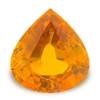Glittering Stones >> Colors Of Gemstones
Colors of gemstones
The most common cause of color in the gemstones is its presence of a very small amount of a transition metal ion. These transition metal ions normally have an incomplete set of 3d electrons. Changes in the energy of these electrons correspond to the energy of its visible light. When white light passes through the colored gemstone and is reflected by it, some of the energy of the visible light is also absorbed, causing 3d electrons in the transition metal ion to undergo its energy change. The light that is transmitted and reflected appears colored because those colors are corresponding to 3d-electron energy transitions have also been absorbed. The table lists several common gemstones, which has chemical compositions, colors, and the origins of these colors.
A ruby is a crystal form of alumina, aluminum oxide, containing a trace of chromium (III) ions replacing some of these aluminum ions. In ruby, each Al3+ ion and Cr3+ ion is surrounded by five oxide ions in an octahedral arrangement. This arrangement splits the five 3d orbitals of Cr3+ into two sets, the orbitals and the dx2-y2 and dz2 orbitals. These two sets normally have different energies. The energy difference between these sets corresponds to its energy of visible light. When white light strikes the ruby, the gem absorbs the light of energy corresponding to the transition of an electron from the lower-energy set of 3d orbital’s to the higher-energy set.
Gem |
Formula |
Color |
Origin of color |
Ruby |
Al 2O3 |
Red |
Cr3+ replacing Al3+ in its octahedral sites |
Emerald |
Be 3 Al 2 (SiO 3 ) 6 |
Green |
Cr3+ replacing Al3+ in its octahedral site |
Alexandrite |
Al 2 BeO 4 |
Red/Green |
Cr3+ replacing Al3+ in its octahedral site |
Garnet |
Mg 3 Al 2 (SiO 4 ) 3 |
Red |
Fe2+ replacing Mg2+ in its 8-coordinate site |
Peridot |
Mg 2 SiO 4 |
Yellow-green |
Fe2+ replacing Mg2+ in its 7-coordinate site |
Tourmaline |
Na 3 Li 3 Al 6 (BO 3 )3 (SiO 3 )6 F 4 |
Pink |
Mn2+ replacing Li+ and Al3+ in its octahedral site |
Turquoise |
Al 6 (PO 4 )4 (OH) 8 • 4H 2 O |
Blue-green |
Cu2+ coordinated to 4 OH¯ and 2 H2O |
Sapphire |
Al 2 O 3 |
Blue |
Intervalence transition between Fe2+ and Ti4+ replacing Al3+ its adjacent octahedral sites |
Aquamarine |
Be 3 Al 2 (SiO 3 ) 6 |
Blue |
Intervalence transition between Fe2+ and Fe3+ replacing Al3+ in adjacent octahedral sites |
Diamond |
C |
Colorless |
Color centers from nitrogen atoms trapped in crystal |
NOVEMBER BIRTHSTONE - CITRINE

COMMEMORATIVE EVENT - 13th Anniversary
KEYWORDS - Success, Abundance, Personal Power
ALSO KNOWN AS - Merchant's stone, Success stone
COLORS - Pale yellow to brown
OCCURRENCE - Brazil
COLOR ZONING - Tiger stripes or Zebra stripes


